The state of Missouri has a wide variety of wildlife habitats and is home to roughly 46 species and subspecies of snakes. Most of these snakes are non-venomous and completely harmless to humans. Even the venomous species only bite humans out of self-defense.
It’s important to be able to distinguish different species for your safety and that of the snake. Not only that, it’s interesting to learn what different kinds of wildlife we share our states with. Let’s take a closer look at the top two dozen harmless snakes you’re likely to find in the state, along with a few venomous snakes to keep an eye out for.

The 28 Snakes Found in Missouri
The 5 Venomous Snakes
1. Osage Copperhead
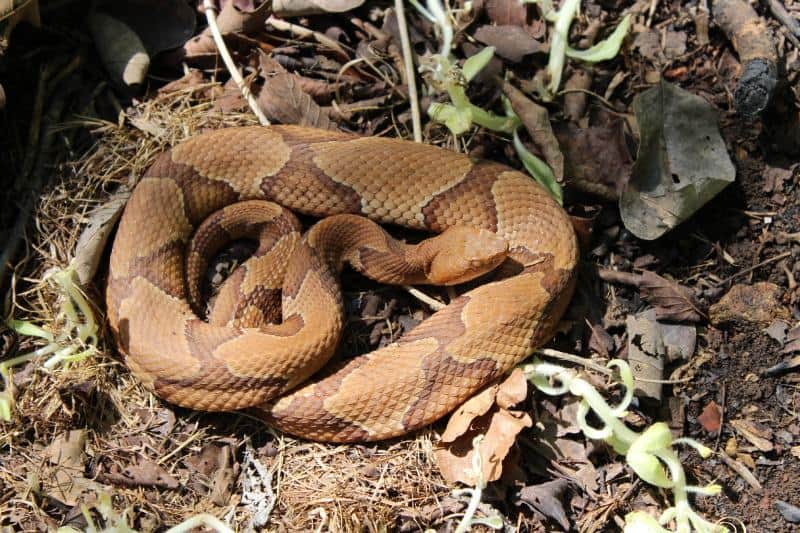
| Species: | Agkistrodon contortrix phaeogaster |
| Longevity: | 15-20 years |
| Good to own as a pet?: | No |
| Legal to own?: | Yes |
| Adult size: | 2-3 feet |
| Diet: | Rodents, lizards, frogs |
In this snake, color varies from grayish-brown to pinkish-tan, with hourglass-shaped crossbands of dark gray, brown, or reddish-brown. The head may have some pink or orange color, hence the name “copperhead.” Copperhead venom is considered mild compared to that of other venomous snakes, but medical treatment should still be sought if a person is bitten.
2. Western Cottonmouth
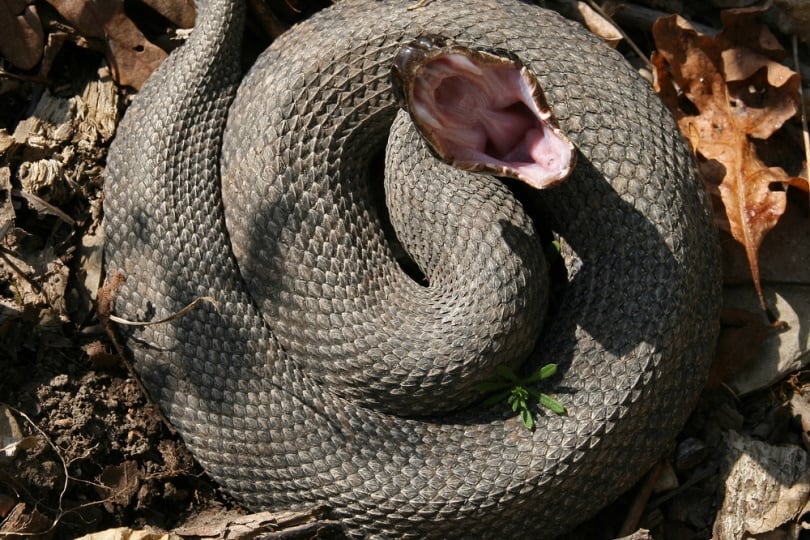
| Species: | Agkistrodon piscivorus leucostoma |
| Longevity: | 15-20 years |
| Good to own as a pet?: | No |
| Legal to own?: | Yes |
| Adult size: | 30-42 inches |
| Diet: | Fish, frogs, rodents, lizards |
The western cottonmouth is primarily found in the southeastern corner of Missouri with some sparse distribution throughout the Ozark region. It gets the name “cottonmouth” from the white coloration inside the mouth that is displayed in times of defense. This snake is semi-aquatic and will be found near bodies of water, they primarily feed on fish.
Related Read: 17 Snakes Found in New York (with Pictures)
3. Timber Rattlesnake
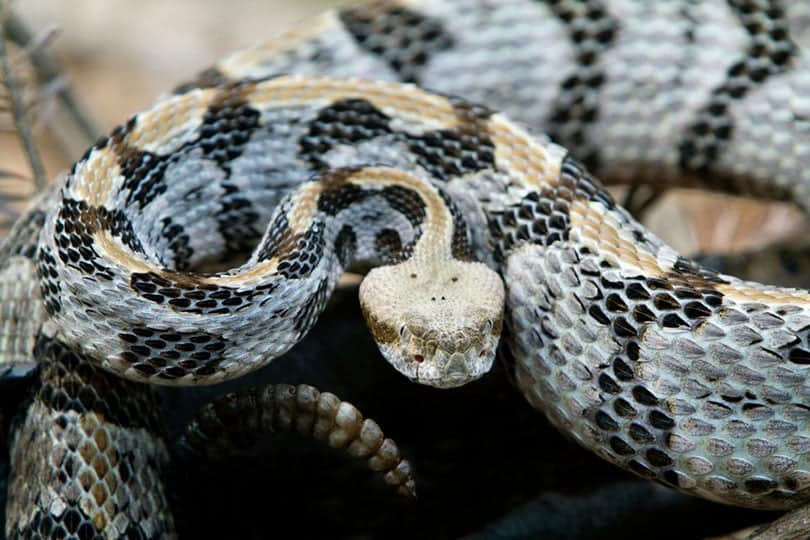
| Species: | Crotalus horridus |
| Longevity: | 10-20 years |
| Good to own as a pet?: | No |
| Legal to own?: | Yes, with a permit |
| Adult size: | 3-5.5 feet |
| Diet: | Rodents |
The timber rattlesnake is Missouri’s largest venomous snake. This snake is found statewide living on rocky, wooded hillsides. They are generally tan in color with a dark brown pattern down their body, complete with a reddish, almost rust-colored stripe down the back. They pack a venomous bite but very few bite incidents are reported.
4. Western Pygmy Rattlesnake

| Species: | Sistrurus miliarius streckeri |
| Longevity: | 15-25 years |
| Good to own as a pet?: | No |
| Legal to own?: | Yes, with a permit |
| Adult size: | 15-24 inches |
| Diet: | Mice, lizards, small snakes, insects |
Found in the counties bordering the Arkansas state line and throughout the eastern Missouri Ozarks, the western pygmy rattlesnake is the smallest in North America. Very few people encounter this species, they tend to be very secretive and are often hiding out under rocks.
5. Eastern Massasauga Rattlesnake
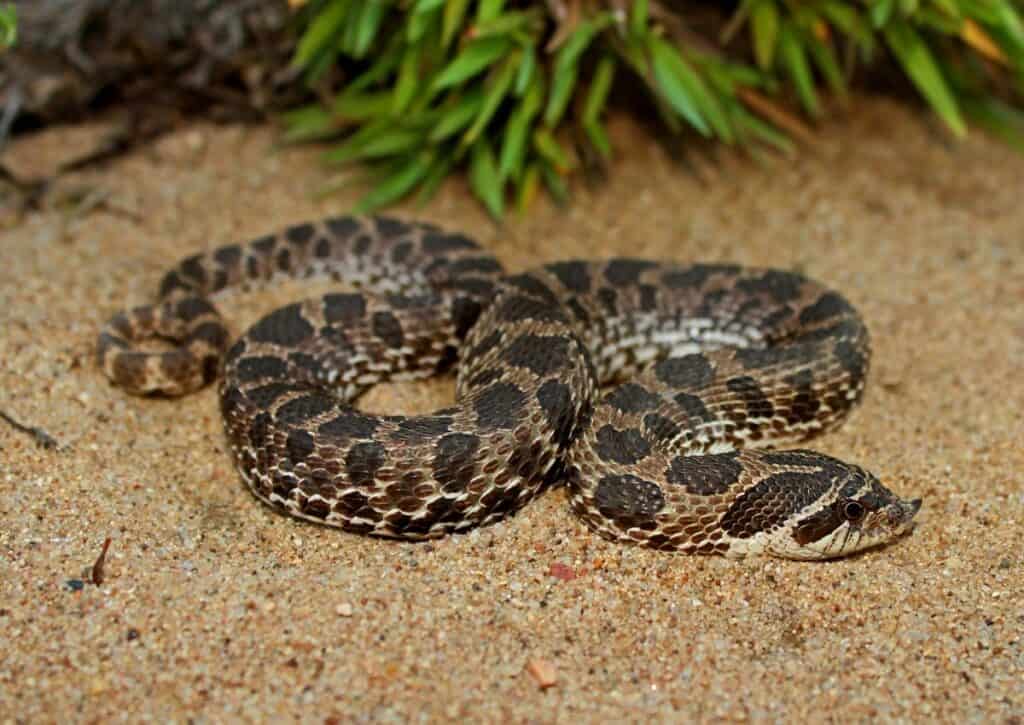
| Species: | Sistrurus catenatus |
| Longevity: | 10-15 years |
| Good to own as a pet?: | No |
| Legal to own?: | Yes |
| Adult size: | 18-30 inches |
| Diet: | Rodents, frogs, lizards |
Found scattered across the northern half of the state, the eastern massasauga rattlesnake is becoming increasingly rare in Missouri due to habitat destruction. This species has a highly venomous bite but human deaths are very rare. This snake is gray with dark brown blotches all over the body.
The 23 Non-Venomous Snakes
6. Earth Snake

| Species: | Haldea striatula, Virginia valeriae |
| Longevity: | 6-10 years |
| Good to own as a pet?: | No |
| Legal to own?: | Yes |
| Adult size: | 7-10 inches |
| Diet: | Earthworms |
There are two earth snakes found in Missouri, the western earth snake found throughout the southern half of the state and the rough earth snake that is also found in the southern portion except for the southeast. Both species are 7 to 10 inches in length and feed primarily on earthworms.
7. Lined Snake
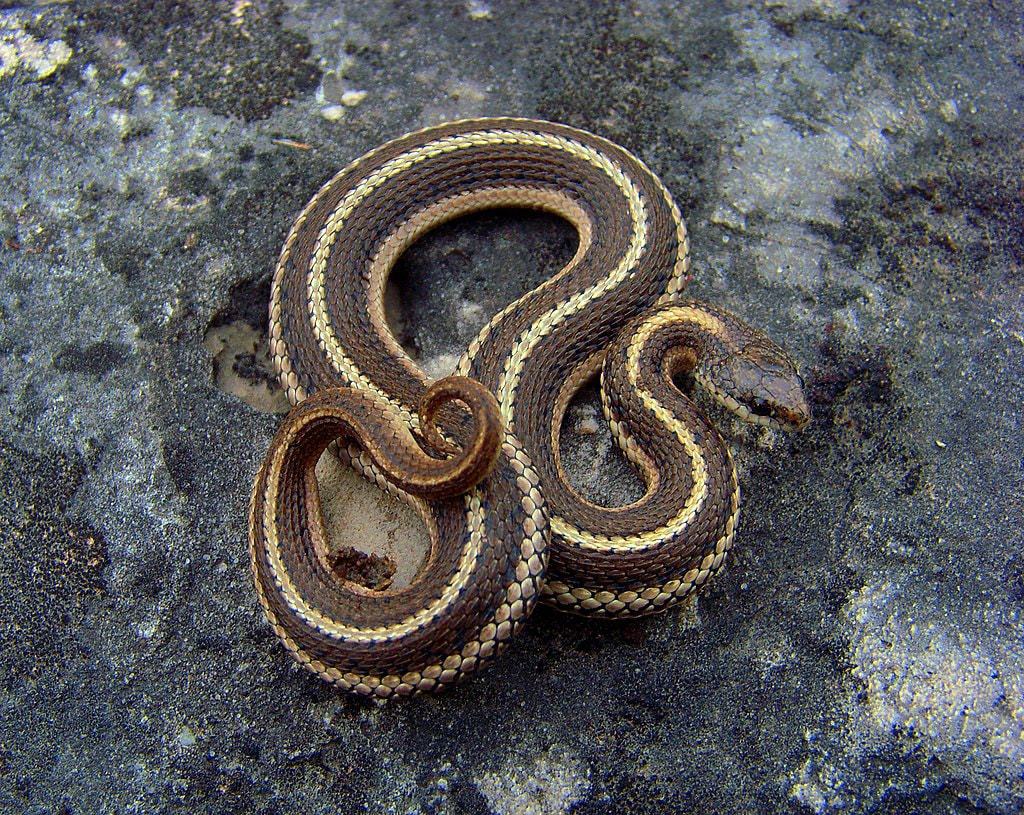
| Species: | Tropidoclonion |
| Longevity: | 3-10 years |
| Good to own as a pet?: | No |
| Legal to own?: | Yes |
| Adult size: | 8-15 inches |
| Diet: | Earthworms |
Located primarily in western Missouri, the lined snake is a small snake that is found in a variety of habitats. Their diet consists mainly of earthworms and they will emit a foul-smelling musk when handled by humans.
8. Garter Snake
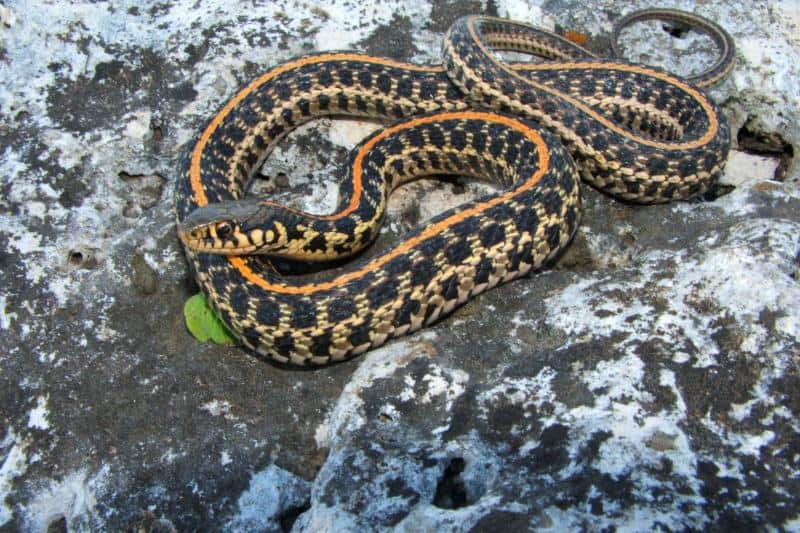
| Species: | Thamnophis radix, Thamnophis sirtalis |
| Longevity: | 4-10 years |
| Good to own as a pet?: | Yes |
| Legal to own?: | Yes |
| Adult size: | 18-26 inches |
| Diet: | Earthworms, frogs, salamanders |
There are five types of garter snakes found in Missouri, the two most popular are the eastern garter snake and the plains garter snake. Garter snakes are harmless species that are typically found near water sources hiding under rocks and vegetation.
9. Western Ribbon Snake
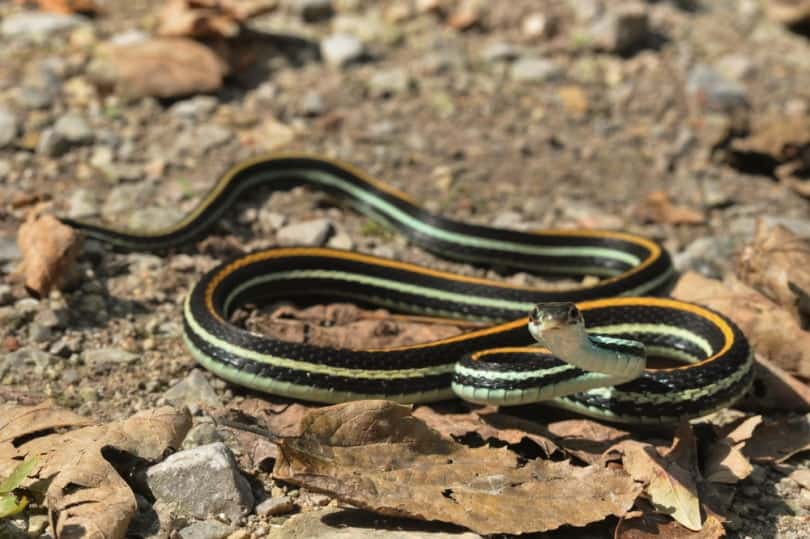
| Species: | Thamnophis Proximus |
| Longevity: | 12-20 years |
| Good to own as a pet?: | No |
| Legal to own?: | Yes |
| Adult size: | 20-30 inches |
| Diet: | Amphibians, small fish, earthworms |
The western ribbon snake is found statewide in Missouri and bears a striking resemblance to the garter snake, as they are closely related. This species inhabits wooded areas near bodies of water and commonly feeds on small frogs and minnows.
10. Flat-Headed Snake
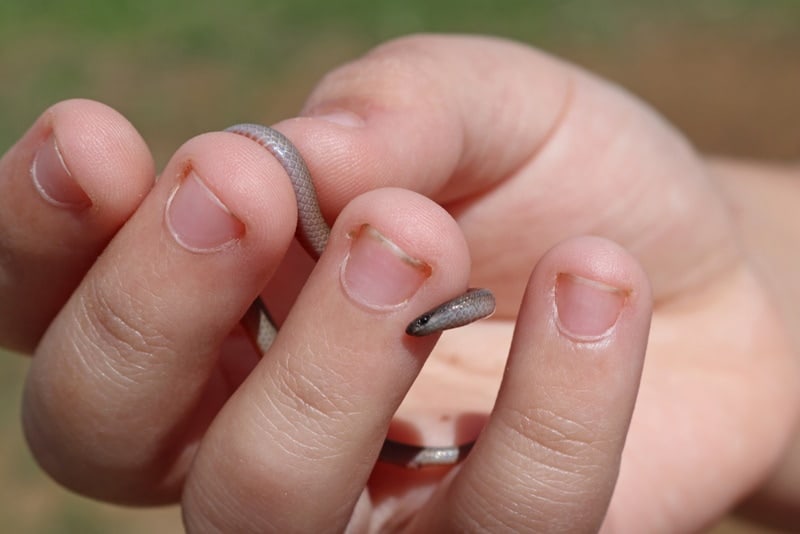
| Species: | Tantilla Gracilis |
| Longevity: | 10-12 years |
| Good to own as a pet?: | No |
| Legal to own?: | Yes |
| Adult size: | 7-8 inches |
| Diet: | Centipedes, insect larvae |
Flat-headed snakes are found in the southern half of Missouri, apart from the southeastern counties. They are very small and tan or grayish to reddish-brown in coloration. They inhabit wooded areas and are typically found in areas with moist soil, hiding under rocks. Their diet consists of centipedes and insect larvae.
11. Northern Red-Bellied Snake
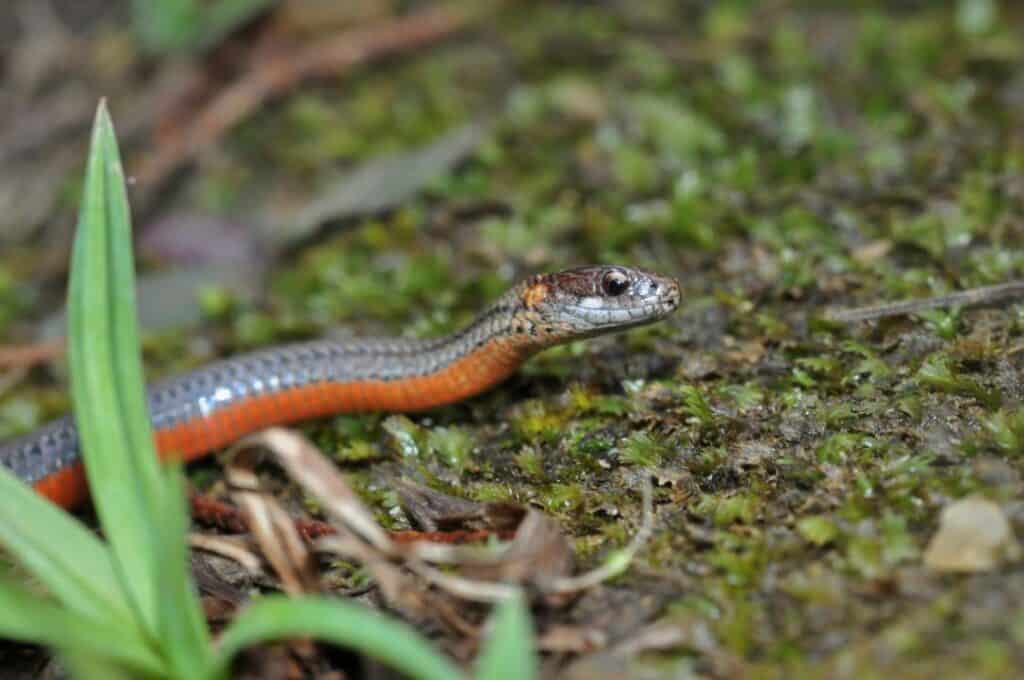
| Species: | Storeria occipitomaculata |
| Longevity: | 3-5 years |
| Good to own as a pet?: | No |
| Legal to own?: | Yes |
| Adult size: | 8-10 inches |
| Diet: | Earthworms, slugs |
This tiny snake has a red-colored belly and inhabits the woodlands all over the state of Missouri. There are several northwestern counties where they lack distribution. They live under rocks and locks and feast on earthworms and slugs.
12. Midland Brown Snake
| Species: | Storeria dekayi |
| Longevity: | 3-7 years |
| Good to own as a pet?: | No |
| Legal to own?: | Yes |
| Adult size: | 9-13 inches |
| Diet: | Earthworms, slugs, snails, soft-bellied insects |
A close relative of the redbelly, the midland brown snake is distributed statewide across Missouri. They are typically found in marshes and swamps under rocks or logs. They have been observed in moist woodland areas as well.
13. Ground Snake
| Species: | Sonora semiannulata |
| Longevity: | 10-15 years |
| Good to own as a pet?: | No |
| Legal to own?: | Yes |
| Adult size: | 8-12 inches |
| Diet: | Scorpions, centipedes, spiders |
Located in the southwest corner of Missouri, the ground snake is variable in coloration and can range from gray, brown, orange, and red body color with dark bands down the body. They prefer rocky woodlands and feed primarily on arachnids.
14. Graham’s Crayfish Snake

| Species: | Regina grahamii |
| Longevity: | 6-10 years |
| Good to own as a pet?: | No |
| Legal to own?: | Yes |
| Adult size: | 18-30 inches |
| Diet: | Crayfish, frogs, snails |
This species is found in crayfish territory near ponds, creeks, and streams and will occasionally feast on frogs and snails. They can be located statewide except for the Ozark area.
15. Bullsnake
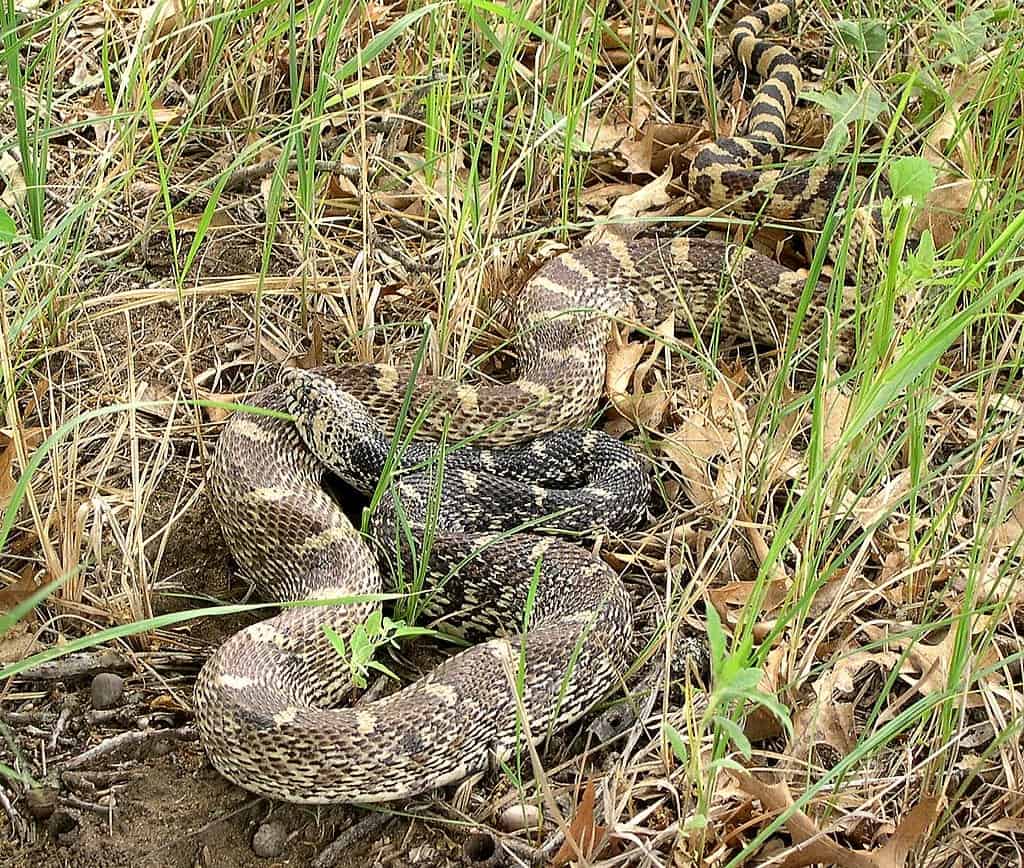
| Species: | Pituophis catenifer sayi |
| Longevity: | 12-30 years |
| Good to own as a pet?: | Yes |
| Legal to own?: | Yes |
| Adult size: | 4-6 ft |
| Diet: | Rodents, birds, lizards |
The bullsnake is absent in southeastern Missouri but is widely distributed elsewhere. They tend to prefer the prairie-like areas and are very popular for their pest-control tendencies.
16. Green Snake
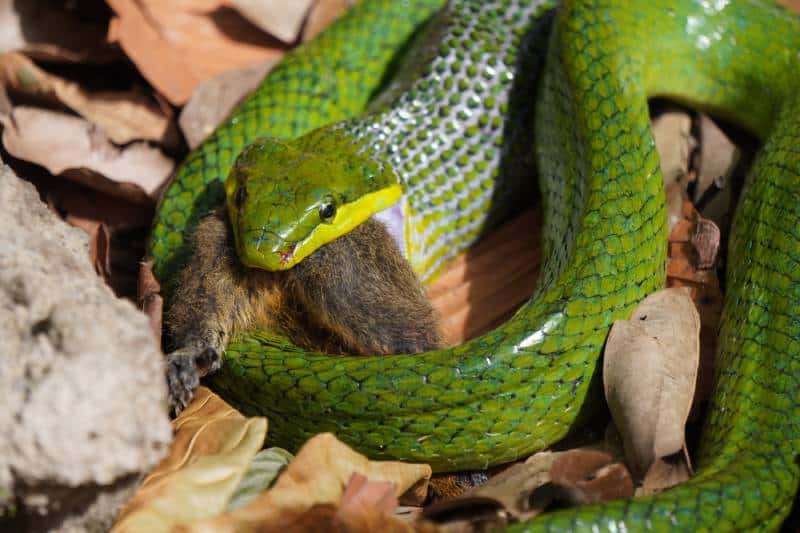
| Species: | Opheodrys aestivus, Opheodrys vernalis |
| Longevity: | 10-15 years |
| Good to own as a pet?: | No |
| Legal to own?: | Yes |
| Adult size: | 20-40 inches |
| Diet: | Crickets, grasshoppers, spiders, and caterpillars |
There were once two varieties of green snakes in Missouri, the rough green snake and the smooth green snake. While the rough green snake can still be found in the Ozarks, the smooth variety is no longer present within state borders due to habitat destruction and is a species of conservation concern. You can tell these two apart by the feel of their scales.
17. Water Snake
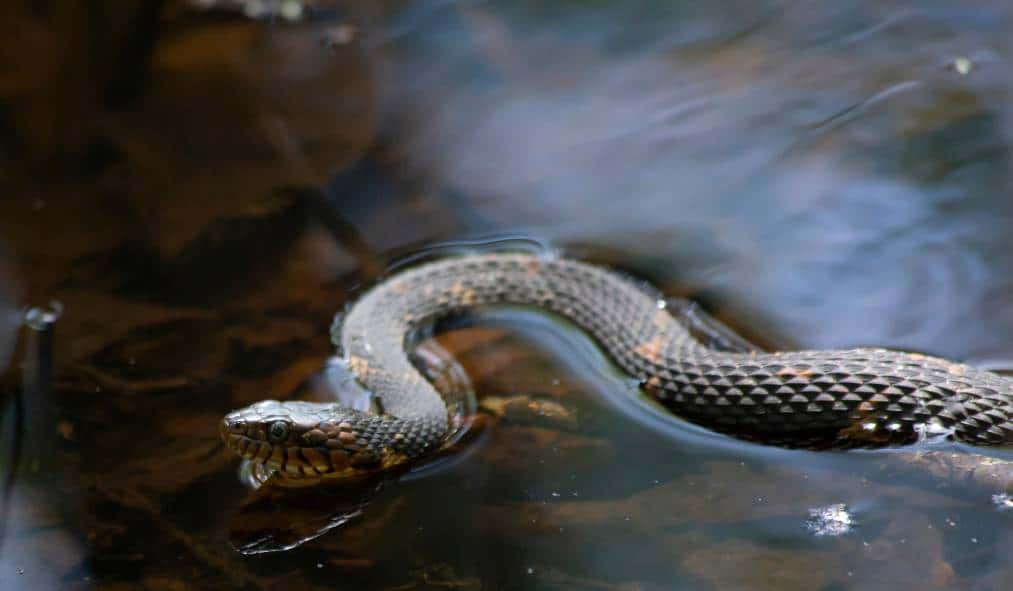
| Species: | Nerodia sipedon, Nerodia rhombifer, Nerodia fasciata, Nerodia erythrogaster, Nerodia cyclopion |
| Longevity: | 6-10 years |
| Good to own as a pet?: | No |
| Legal to own?: | Yes |
| Adult size: | 20-48 inches |
| Diet: | Fish, amphibians, crayfish |
Missouri’s native water snakes include the northern water snake, the diamond-backed water snake, the yellow-bellied water snake, and the Mississippi green water snake. Their habitat consists of ponds, lakes, streams, rivers, and wetland areas. As with most water snakes, they can be confused with the venomous cottonmouth. These snakes are non-venomous but will emit a foul-smelling musk when intimidated. They are harmless to humans.
18. Eastern Coachwhip
| Species: | Masticophis flagellum |
| Longevity: | 10-16 years |
| Good to own as a pet?: | No |
| Legal to own?: | Yes |
| Adult size: | 3-6 feet |
| Diet: | Rodents, lizards, snakes, small birds |
Located throughout the southern half of Missouri, the eastern coachwhip is a fast-moving, lengthy snake that will vibrate its tail when on the defensive to mimic a rattlesnake. They are harmless to humans.
19. Milk Snake

| Species: | Lampropeltis Triangulum |
| Longevity: | 10-20 years |
| Good to own as a pet?: | Yes |
| Legal to own?: | Yes |
| Adult size: | 21-28 inches |
| Diet: | Lizards, snakes, rodents |
The milk snake often is misidentified as a coral snake, which is not found in Missouri. The milk snake is secretive and seldom seen in the open. It shelters under rocks and logs or in rodent burrows.
20. Kingsnake

| Species: | Lampropeltis holbrooki, Lampropeltis calligaster, |
| Longevity: | 15-30 years |
| Good to own as a pet?: | Yes |
| Legal to own?: | Yes |
| Adult size: | 30-48 inches |
| Diet: | Rodents, lizards, snakes |
The prairie kingsnake and the speckled kingsnake are native to Missouri and found statewide. Kingsnakes typically spend their days under rocks, brush, or inside of burrows. Kingsnakes eat other snakes and are unharmed by the bite of any of the native venomous snakes.
21. Hognose Snake

| Species: | Heterodon nasicus, Heterodon platirhinos |
| Longevity: | 10-20 years |
| Good to own as a pet?: | No |
| Legal to own?: | Yes |
| Adult size: | 16-33 inches |
| Diet: | Toads, amphibians, lizards, small rodents |
This snake is easily identified by its signature pointed, upturned snout. Hog-nosed snakes are rear-fanged. Their saliva has been found to have some toxic properties that only affect their prey. They are no danger to humans. The two species common to Missouri are the eastern hognose and the plains hognose.
22. Western Mud Snake
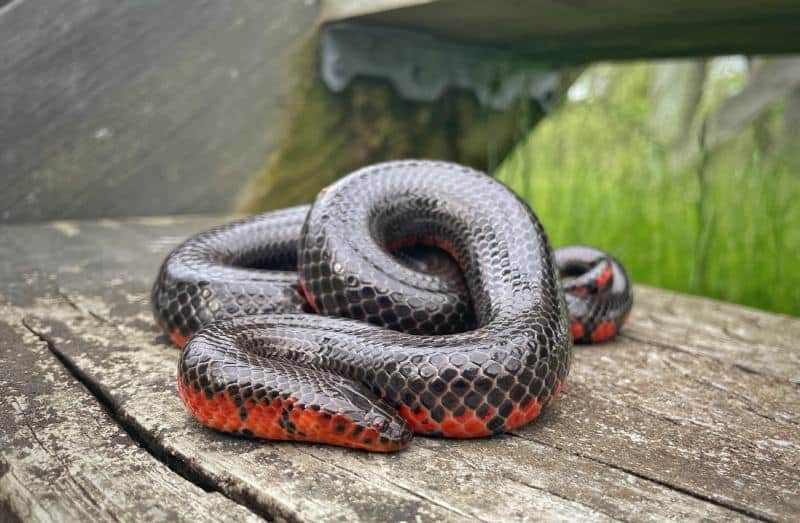
| Species: | Farancia abacura |
| Longevity: | 10-20 years |
| Good to own as a pet?: | No |
| Legal to own?: | Yes |
| Adult size: | 3-5.5 feet |
| Diet: | Salamanders, tadpoles, fish |
Found in floodplains and swampy areas, this snake is nocturnal and is commonly seen crossing roads in swampy areas on rainy nights. They are found in the southeastern corner of Missouri and feed on salamanders, tadpoles, and small fish.
23. Western Fox Snake
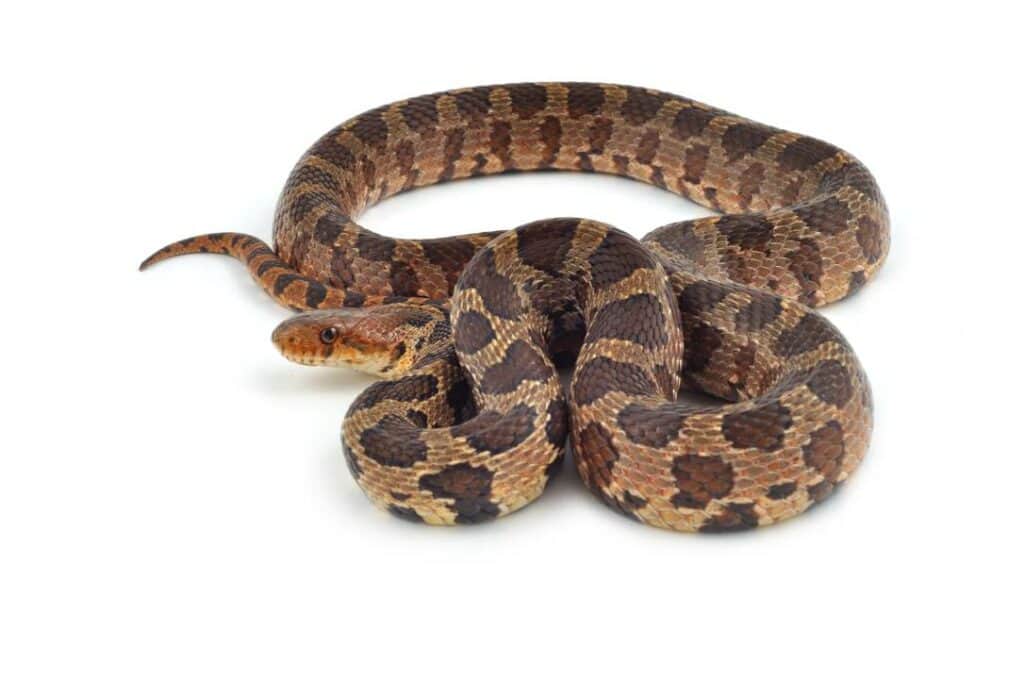
| Species: | Pantherophis vulpinus |
| Longevity: | 12-20 years |
| Good to own as a pet?: | No |
| Legal to own?: | Yes |
| Adult size: | 3-5.5 ft |
| Diet: | Rodents, birds |
The western fox snake is a marsh-dwelling member of the rat snake family. They are located across the northern part of Missouri. They have a distinct black checkered pattern and are not common to find.
24. Rat Snake

| Species: | Pantherophis obsoletus, Pantherophis emoryi |
| Longevity: | 10-15 years |
| Good to own as a pet?: | No |
| Legal to own?: | Yes |
| Adult size: | 2-6 feet |
| Diet: | Rodents, birds |
The black rat snake and the plains rat snake are two popular species of rat snake located in the state. They can both get quite lengthy, maxing out around 6 feet. The black rat snake is found statewide, while the plains rat snake is found in the southern half of the state along the Missouri River. The plains rat snake has a distinct pattern and is light tan in body color.
25. Prairie Ring-Necked Snake
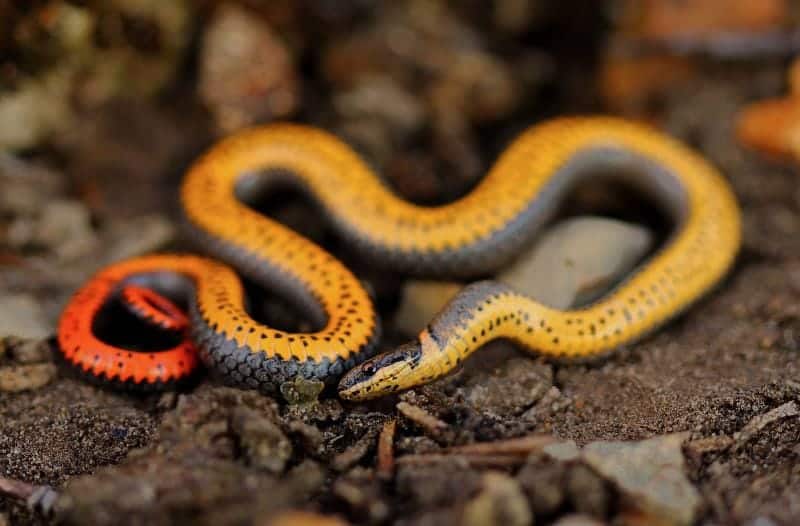
| Species: | Diadophis punctatus |
| Longevity: | 6-10 years |
| Good to own as a pet?: | No |
| Legal to own?: | Yes |
| Adult size: | 10-14 inches |
| Diet: | Worms, slugs, soft-bellied insects |
Easily recognized by the bright yellow band resembling a collar around their neck, this species is found statewide and feasts on worms, slugs, and insects.
26. Eastern Yellow-Bellied Racer
| Species: | Coluber constrictor flaviventris |
| Longevity: | 8-12 years |
| Good to own as a pet?: | No |
| Legal to own?: | Yes |
| Adult size: | 30-50 inches |
| Diet: | Frogs, lizards, rodents, birds |
Also known as the blue racer, this snake is distributed throughout the whole state of Missouri. They prefer fields, grasslands, and open wooded areas. They have a variable diet consisting of frogs, lizards, rodents, and birds.
27. Northern Scarlet Snake
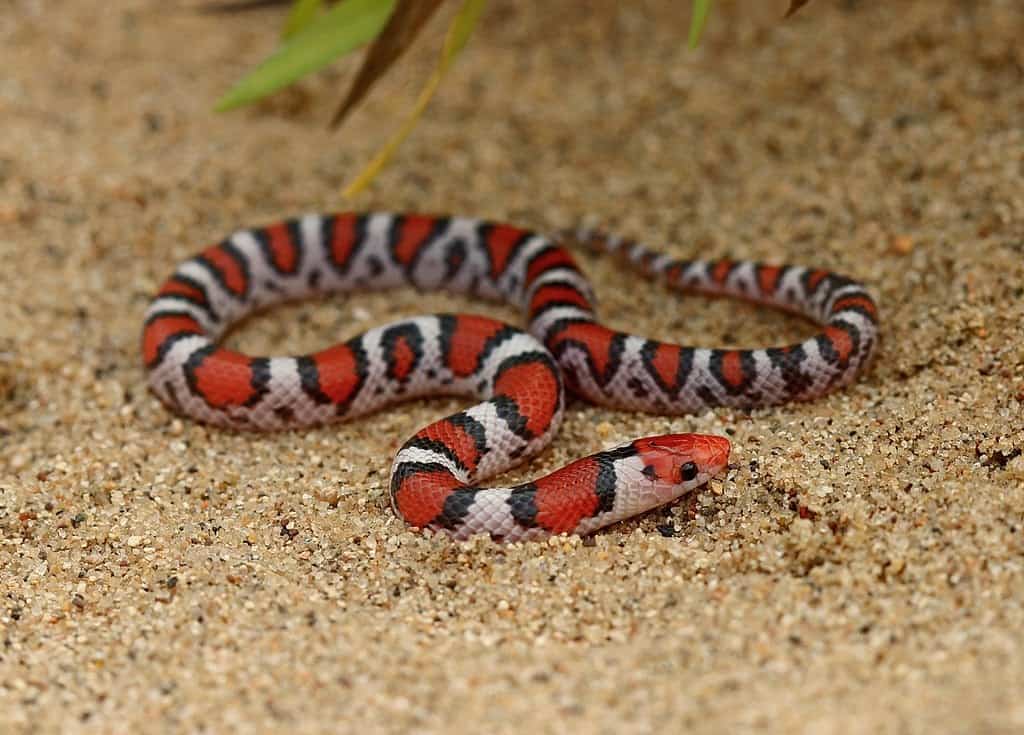
| Species: | Cemophora coccinea |
| Longevity: | 10-15 years |
| Good to own as a pet?: | No |
| Legal to own?: | Yes |
| Adult size: | 1-2 feet |
| Diet: | Eggs, rodents, lizards |
The northern scarlet snakes are very vibrant in color and are found in south-central Missouri. They have a similar pattern to the milk snake. They are light in body color covered in red to orange blotchy patterns. They spend most of their life underground and only emerge to eat.
28. Western Worm Snake

| Species: | Carphophis vermis |
| Longevity: | 2-5 years |
| Good to own as a pet?: | No |
| Legal to own?: | Yes |
| Adult size: | 7-11 inches |
| Diet: | Earthworms, insect larvae |
This small, purplish-brown snake has a salmon-colored belly. They are found all over the wooded Missouri hillsides. Their diet consists of earthworms, insect larvae, and eggs.
Conclusion
As you can see, there are various venomous and non-venomous snake species in the state of Missouri. Whether you’re on a hiking excursion or just wanting to learn more about the snakes in your area, there is no shortage of variety.
It is never recommended to take a wild snake from its habitat and make it into a pet. Some of these species can make great pets but you will want to locate a breeder that can offer you a captive-bred animal.
Venomous snakes can be owned in Missouri with a proper permit. It is not recommended to take these kinds of snakes on as a novice pet owner. Venomous snakes should only be housed by the most experienced reptile handlers, zoos, and conservationists.
Related read:
Featured Image Credit: Ken Griffiths, Shutterstock
